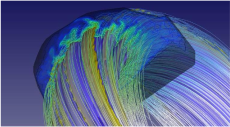A New Class of Tokamak Nonlinear Plasma Instability
A Tokamak is a toroidal-shaped fusion vessel in which a plasma, which is a mixture of the hydrogen isotopes deuterium and tritium that has been heated to extremely high temperatures, is confined inside entirely by strong magnetic fields. Many believe that the tokamak is the best candidate for producing controlled thermonuclear fusion power.
Key Challenges: The confinement and stability properties of the edge of a magnetically confined fusion plasma have long resisted theoretical explanation but may constitute a constraint on the design of next generation fusion experiments such as ITER. Codes that solve 3D fluid equations for device-scale stability need to operate at physical scales spanning nearly three orders of magnitude.
Why it matters: It is the plasma edge that, to a large extent, will determine if magnetically confined in-vessel fusion is feasible. The steep edge pressure gradient and associated plasma current can drive large periodic instabilities that erode the edge and dump plasma and energy onto the surrounding walls.
Accomplishments: Linda Sugiyama of MIT used the extended magnetohydrodynamics (MHD) code M3D on a few hundred processors of Franklin. The code solves the compressible resistive MHD equations, including separate density and temperature, over the entire region. The simulations showed that Edge Localized Modes (ELMs) in high temperature, toroidal fusion plasmas constitute a new class of nonlinear plasma instability. The instability couples to the magnetic field driving field perturbation deep into the plasma. The work was featured in invited talks at APS and at SciDAC09. Researchers at MIT now believe that with these results they have taken steps toward practical fusion energy through better understanding of the physics that governs the interaction between plasmas and the material walls of the vessels that contain them.
NERSC Contribution: Visualization of the results was done in collaboration with NERSC staff using the Cray XT4.
Investigators: Linda Sugiyama, MIT
More Information: See J. Phys: Conf. Ser. 180 (2009) 012060 and the MIT Plasma Science & Fusion CenterMIT Plasma Science & Fusion Center








